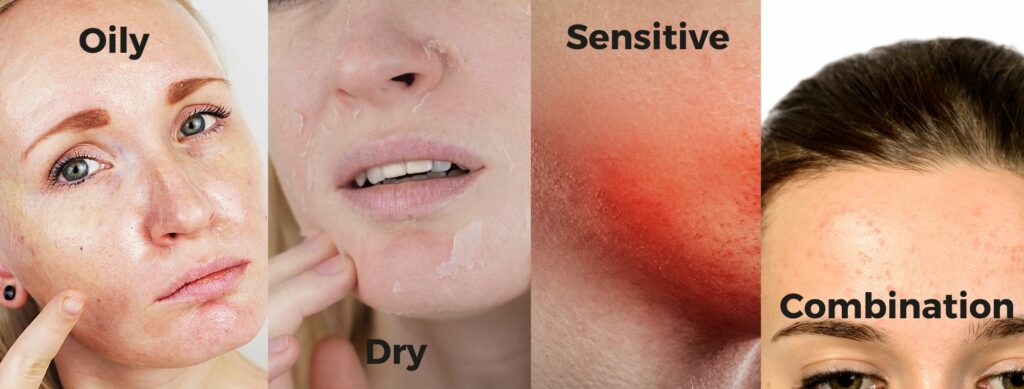What Skin Type Do I Have? Discovering The Different Skin Types

Understanding the differences in skin type is important for everyone, regardless if you are an aspiring beauty therapist, aesthetician or skincare fanatic. There are 5 common skin types which impact the products you use, how your skin deals with weather conditions and more.
The type of skin you have is determined by genetics, however, your skin type can change based on hormones, diet and other factors. These factors can include pregnancy, medication and more.

The various skin types are:
- Oily
- Dry
- Normal
- Combination
- Sensitive
Depending on your type of skin will change how you cleanse and maintain it. So, knowing which type of skin you have is the first step in creating the perfect skincare routine.
Oily Skin
As the name implies, those with oily skin will have skin that produces an excess amount of sebum. The excess sebum causes our skin to look greasy and extra shiny – not the good shiny either. If you have oily skin, you might notice that you’re extra slick in your T-zone (forehead, nose and chin).
Depending on the time of the year, your oiliness may vary. However, you are most likely never without a shiny face by the end of the day, even in winter!
If you have oily skin, you are also more likely to have enlarged pores. These enlarged pores often get clogged and lead to acne.
Dry Skin
Another skin type that is quite common and on the other side of the spectrum from oily skin is dry skin. Those with dry skin have a skin type that produces less sebum than normal skin. The lack of sebum causes the skin to retain moisture, leading to dull and rough skin.
Again, depending on the time of the year, you might find your skin drier than usual. If you have dry skin, winter makes it hard to keep your skin hydrated, even leading to flaky, blotchy or scaled skin.
Those with dry skin type may notice that their pores are almost invisible. You may also find that after cleansing the face, the skin is extra tight and shows fine lines.
Normal Skin
Those with a normal skin type are neither too oily nor too dry. The skin is perfectly balanced with little blemishes and imperfections. You would also not need any special maintenance with normal skin, so there isn’t much to write about this skin.
Combination Skin
With combination skin, you have both oily and dry skin. Combination skin can be very challenging as different areas of the face require unique cleansing and maintenance.
So, you might find that your t-zone is oily whilst your cheeks are dry or normal. Combination skin occurs when sebum production is not consistent throughout the face.
Sensitive Skin Type
The final most common skin type is sensitive skin type. As the name implies, those with sensitive skin have skin that is sensitive to many things. Unlike the other skin types, you can have sensitive skin alongside dry, oily and combination skin. Not fun, right?
Sensitive skin can feel burning, itchy and raw, making it hard to find non-irritating products.
For many people, sensitive skin is their natural skin type and the skin type they will have for their whole life. For others, their skin sensitivity temporarily increases due to products, environment or hormones.
Hopefully, these descriptions can help you figure out what skin type you are, but if not, dermatologists recommend a simple test. Complete this test at home if you are unsure which of the above skin types you have.
How to Figure out What Skin Type You Have?
The next time you wash your face, monitor how you’re skin behaves after to figure out your skin type. Don’t add any products to your face, then wait for 30 minutes and check the condition of your face once the time has passed.
You most likely have dry skin if your face feels scaly and tight. If you notice that your face is shiny all over, then you have oily skin, but if you’re only shiny in your t-zone, then you have combination skin.
Simple, right?
It’s vital to understand your skin to better your skincare and overall maintenance, but also for health reasons. Those who know their skin well are more likely to notice any sudden changes, which can be a sign of underlying health issues.
If you are looking to check out some of our other blogs on skin and skincare, why not read: